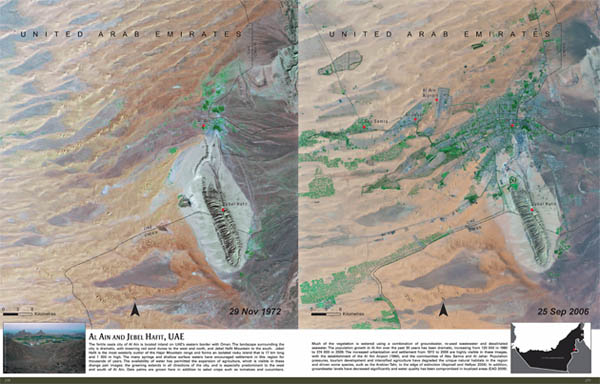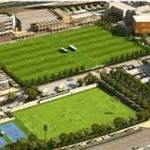UN report says Arab region could be home to the fastest changing environment in the world as a result of growing population and environmental pressures.
A country with limited water, fertile land, food and biodiversity is the dystopian picture presented by an international report if no action is taken to protect the UAE environment.
The Arab region could be home to the fastest changing environment in the world as a result of growing population and environmental pressures, the United Nations Environment Programme (UNEP) says.
The agency has produced a comprehensive 300-page report on the environmental development of the 22 Arab League states using information and images from as far back as 1980, comparing historical and contemporary data.
The atlas uses “state-of-the-art space-borne and aerial images, maps, graphics and photographs” to highlight both natural and human-caused landscape changes”.
It identifies three environmental flash points for the UAE: water demand and scarcity; land degradation and desertification; and threats to coastal and marine ecosystems. It gives the context of how the discovery of oil and gas in the country turned it into a “booming economy”.
“This rapid economic expansion, coupled with population growth that is fueled by the influx of expatriates…presents significant environmental challenges.”
UNEP West Asia regional office Officer-of-Charge, Dr Adel Abdel-Kader, said ambitious plans in many Arab countries meant increased pressure on scarce renewable natural resources, “especially water and land producing food”.
“The increase in population will also mean an increase in energy use and release of emissions from burning energy. It will also lead to increased waste and generates challenges for waste management.”
He identified water scarcity as the most pressing concern for the UAE. The report says the country, which is the second largest producer of desalinated water in the world after Saudi Arabia, uses up groundwater supplies at a rate 24 times the “natural recharge capacity”. Liwa groundwater supplies are projected to be depleted within 40 years. Alarmingly, despite the lack of water, the UAE is the third largest per capita water consumer in the world.
“By 2025, water demand in the UAE is expected to increase by 44 per cent to 3.2 thousand million (metres cubed).”
“There is a need to reconsider agriculture policies and uses of water in agriculture. Integrated water resource management need to be adopted as a key policy option,” Abdel-Kader said. The report is intended to be a driver of policy change.
The “rapid development of industry” is also linked to pollution threatening coastal and marine ecosystems.
“It is estimated that two million barrels of oil are spilt annually into the sea area. Major declines in fish stocks have been documented due to fishing pressure, habitat degradation (pollution, dredging, land reclamation and channelling of the seabed) and environmental changes.”
“Uncontrolled development and land reclamation programmes” have damaged coral reefs, mangroves and sea bed, while sand dunes mined and leveled in the name of development have caused habitat and biodiversity loss.
It also looks at the development of the coastline in Dubai and the construction of artificial islands, saying the UAE’s largest reef, the Jebel Ali reef, has been “negatively impacted” as a result of sediment from dredging or changes in water flow. “Many of these man-made structures also create new habitats; for example, coral species are recruiting in fairly high abundance on the rocky breakwater structures surrounding the islands.”
The report says the future of natural reefs is in jeopardy. “Management and reduction of planned real estate development and desalination facilities are important steps in addressing this issue.”
The report says almost the entire country is desertified. The infertile soil is prone to waterlogging which kills vegetation and decreases productivity of agricultural lands, while vegetation that has been overgrazed by livestock has increased desertification.
“Aggressive efforts are being made to combat desertification through legislation and establishment of natural reserves and greenbelts,” the report noted.
The report congratulates the country for conservation efforts in Al Ain. “The greening of the desert shown in images of Al Ain…are testament to efforts in the region to improve environmental conditions and conserve water resources.”
The Environment Agency – Abu Dhabi, which helped compile and release the report, said it brought to light the environmental changes taking place — and how humans had both positively and negatively altered their surroundings.
“Although the challenges depicted are striking, the atlas examines the opportunities that these challenges represent, as well as some of the innovative responses that are being implemented in the region,” a spokesperson said.
The agency also said the report served as a caution.
“The atlas images serve to highlight the distinctive environmental circumstances and challenges faced by the Arab region, from limited freshwater resources, rapid urbanisation, depletion of natural resources and the vulnerability of many Arab settlements to environmental risks and natural disasters.”



